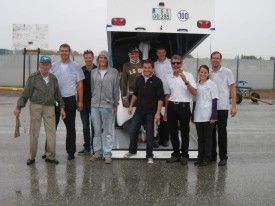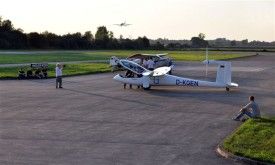The electric two-seater e-Genius just spent a week in Serres (France) a location which is also known as Klaus Ohlmann’s home airfield. Further evaluation and – if possible – some records were on the to-do-list. Seven records were achieved!
As you might remember from former Soaring Café articles the electric glider e-Genius was built by a team of enthusiastic professional aircraft designers, students, pilots and engineers in Stuttgart in just 9 months. The goal was to compete in the CAFE Foundation’s Green Flight Challenge in Santa Rosa, California in 2011. E-Genius finished this competition “only” coming in as second, but later when Klaus Ohlmann piloted the extraordinary ship at the Green Speed Cup in Strausberg near Berlin, he won the competition. The Green Speed Cup, where conventional or diesel engines are allowed as well, scores energy use, distance and speed to determine the most efficient aircraft.
During the past July 2014 week in France, Klaus and the unique airship broke the magic number of seven new world records. Two flights executed on July, 18th and 19th had the following results, which are now according to Klaus’ French website waiting for FAI approval:
– Airspeed on a 100 km out and return distance: 178,1 km/h
– Airspeed during 500 km out and return: 93,03 km/h
– Distance of 504 km
– Absolute altitude gain: 6376m
– Time to climb up to 6000 m: 1 h 53 min
– Altitude kept during at least 90s: 6350m
– Airspeed in a straight line of 15 km: 229,7 km/h
E-Genius uses only a 450 V Lithium Polymer battery with a capacity of 50 Ah, no fuel! With its output of 80 kWh the powered glider can supposedly cover about 500 km at an average speed of 150 km/h, in calm air. Its maximum weight is with 900 kg somewhat higher than an average twin glider’s, but the battery already weighs 280 kg. Batteries will probably be smaller and lighter in the future.
With these new records in the books, Klaus is confident that the use of electric engines in airplanes (in gliders as well as in powered aircraft) will be worth the research effort. Maybe in some years electric propulsion systems will already be the new standard? E-Genius is a design in the still small family of electric-powered gliders which gives hope for more: Imagine how two people could fly a distance of 100 km at 180 km/h only using 25 kWh. If you want to calculate the costs for a flight like this, just have a look into your last energy bill… It’s almost nothing. Taking this a little further, enjoy another look at Sunseeker II and Sunseeker Duo: Solar panels take care of these gliders’ energy supply! No power station required – only sunlight!
Congratulations to Klaus on his achievements! So far most of the new electric- / solar-powered developments are unique aircraft, but with these records the world might take electric flight to the next level!








